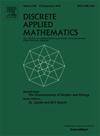On almost bipartite non-König–Egerváry graphs
IF 1
3区 数学
Q3 MATHEMATICS, APPLIED
引用次数: 0
Abstract
A set is independent in a graph if no two vertices from are adjacent. The independence number is the cardinality of a maximum independent set, while is the size of a maximum matching in . If equals the order of , then is a König–Egerváry graph (Deming, 1979; Gavril, 1977; Sterboul, 1979). The number is the critical difference of (Zhang, 1990) (where ). It is known that the inequality holds for every graph (Levit and Mandrescu, 2012; Lorentzen, 1966; Schrijver, 2003).
A graph is (i) unicyclic if it has a unique cycle, (ii) almost bipartite if it has only one odd cycle. Let is a critical independent set of , core be the intersection of all maximum independent sets, and corona be the union of all maximum independent sets of . It is known that for every graph (Levit and Mandrescu, 2012), while the equality holds for bipartite graphs (Levit and Mandrescu, 2013), and for unicyclic non-König–Egerváry graphs (Levit and Mandrescu, 2014).
In this paper, we prove that if is an almost bipartite non-König–Egerváry graph, then ker core, corona(core()) = , and .
求助全文
约1分钟内获得全文
求助全文
来源期刊

Discrete Applied Mathematics
数学-应用数学
CiteScore
2.30
自引率
9.10%
发文量
422
审稿时长
4.5 months
期刊介绍:
The aim of Discrete Applied Mathematics is to bring together research papers in different areas of algorithmic and applicable discrete mathematics as well as applications of combinatorial mathematics to informatics and various areas of science and technology. Contributions presented to the journal can be research papers, short notes, surveys, and possibly research problems. The "Communications" section will be devoted to the fastest possible publication of recent research results that are checked and recommended for publication by a member of the Editorial Board. The journal will also publish a limited number of book announcements as well as proceedings of conferences. These proceedings will be fully refereed and adhere to the normal standards of the journal.
Potential authors are advised to view the journal and the open calls-for-papers of special issues before submitting their manuscripts. Only high-quality, original work that is within the scope of the journal or the targeted special issue will be considered.
 求助内容:
求助内容: 应助结果提醒方式:
应助结果提醒方式:


